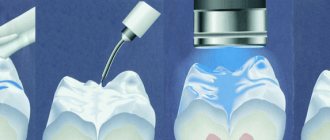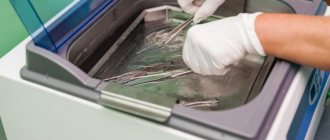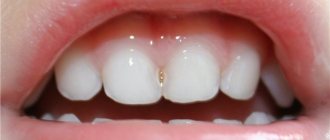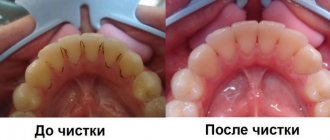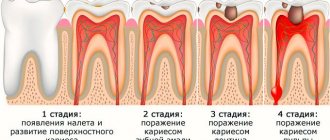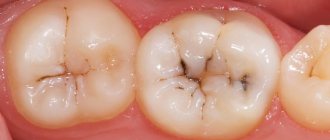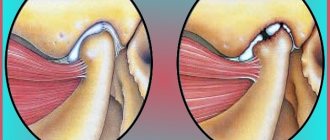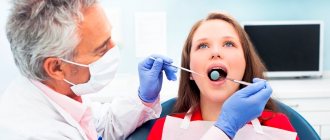What is physiotherapy of teeth and gums with calcium, laser, current? What is the best physical therapy in dentistry? How much does physiotherapeutic treatment in dentistry in Moscow cost, inexpensively, at a discount, at a promotion? Read more...
Physiotherapeutic methods of treatment in dentistry Physiotherapy for the oral cavity Physiotherapy of teeth Physiotherapy of gums Physiotherapy, price in Moscow
Chief physician, Salatsky Dmitry Nikolaevich
Sign up for a free consultation
+7
Types of physiotherapy and mechanism of action
Under the influence of various physical factors, the physiological processes of the body are activated. With the rational use of physical therapy in dentistry, it is possible to control these processes and obtain the desired result.
Depending on the type of impact factor, there are different types of physiotherapy.
| Physical factor | Physiotherapy |
| Electric current (alternating, direct, high or low frequency, strength, voltage) | Depophoresis Galvanization and electrophoresis Amplipulsetherapy Fluctuarization Darsonvalization Ultratone therapy UHF therapy |
| Light | Laser therapy |
| Warm | Paraffin therapy Mud therapy |
| Ozone Air particles | Ozone therapy Aeroinotherapy |
| A magnetic field | Magnetotherapy |
| Oscillations (mechanical, electromagnetic) | Ultrasound therapy Microwave therapy |
| Pressure | Massage (hydromassage, vacuum, manual) |
Against the background of activation of the physiological processes of the body, the following effects are observed:
- Stimulation of the immunobiological system.
- Desensitization.
- Activation of the endocrine glands (pituitary gland, thyroid gland).
- Regulation of hematopoietic function.
- Improving collateral blood flow.
- Abundant supply of tissues with oxygen.
- Strengthening regenerative processes (fast wound healing).
- Activation of the anticoagulant system.
- Production of endorphins, which has an analgesic effect.
- Activation of proteolytic enzymes and leukocytes in the lesion, which leads to a bactericidal effect.
The method of physical influence should be carefully chosen, taking into account both the local and general reaction of the body. The result for each patient may be different depending on the general condition and clinical picture of the disease.
Mechanism for the procedure
Ultrasonic teeth cleaning is performed through the operation of a special device called an ultrasonic scaler. The device is used by the dentist for professional cleaning and removal of soft and hard plaque. This technology is the most optimal, as it completely protects the tooth surface from unnecessary damage. Unlike mechanical effects, ultrasonic is produced through the action of sound waves of a certain frequency and amplitude.
Dentists recommend carrying out the procedure at least once every six months. Such frequency will definitely eliminate the possibility of caries, dark plaque, tartar, and bad breath. After ultrasonic treatment of tooth enamel, sometimes patients experience short-term pain in the area where deposits required more thorough treatment with an ultrasonic scaler. But this is a completely normal phenomenon that does not require quenching with special means. It is impossible to determine exactly how long the patient will experience such discomfort, because it depends on the initial state of the enamel.
To make sure that all steps to remove deposits are completely simple, you can watch the video. In terms of time, cleaning takes about an hour if this is a repeated intervention. The dentist will not be able to immediately determine exactly how long the removal of deposits will last in advanced situations. Immediately before the procedure, the surface of the tooth enamel is treated with a special gel that reduces friction. In addition, this gel, as a result of interaction with the device, releases oxygen, which acts on the layers of plaque and peels it off. The cleaning is deep and even penetrates into the dental canals, rinsing them. In the photo you can see the result.
Indications
Physiotherapeutic procedures are absolutely safe for the human body. But only if the physiotherapist correctly selects the type of procedure, power and time of exposure.
A high therapeutic effect will be achieved only in complex treatment. The dentist must build a complete treatment plan for the disease, including physical therapy.
Physiotherapy can be carried out in the following cases:
- Acute and chronic inflammatory processes.
- Poor blood circulation in the oral mucosa and gums.
- Regeneration and degenerative processes of tissues.
- Painful sensations.
- Surgical intervention.
- Decreased muscle tone and nerve patency.
- Prevention and rehabilitation.
- Children's age from 1 year.
The main positive feature is that the procedure does not affect the entire body. Therefore, the results of local treatment are predictable and easily controlled.
Physiotherapeutic methods of treatment in dentistry
Dental physiotherapy of teeth and gums - what is it? What does a dental physiotherapist do?
Paradoxically, this is the oldest branch of medical science. The term itself is translated from Greek as “natural medicine”. Treatment with the beneficial effects of various physical factors has been known since the times of ancient civilizations: Sumerian, Babylonian, Greek, Roman.
0%
Installment plan without overpayments
Start treatment today!
Take advantage of interest-free installments for 2 years without a down payment
Find out more
8
Payment by installments is possible without bank participation
In the 21st century, the indications for oral dental physiotherapy have expanded significantly, but the basic principles formulated by ancient doctors are still the most important today. Modern views in medicine in general and dental physiotherapy in particular are based on the principle of “treating the patient, not the disease.”
The main task of physical or pharmacological influence on the patient’s body is the normalization of metabolic processes at all levels, organismal, tissue and cellular. This is exactly what is required to restore the functions of organs and systems disturbed by the course of the disease, especially in such complex diseases as TMJ dysfunction and with complex gnathological treatment.
Physiotherapy in dentistry, photo
Everyone knows the catchphrase “movement is life” and therefore the main task of the dentist - physiotherapist is to select the necessary physiotherapeutic technique aimed at restoring the functioning of muscles, ligaments, joints both in the maxillofacial area and in the body as a whole, and to return the patient freedom of movement and fullness of sensations due to the restoration of metabolic processes.
Methods and methods of physiotherapeutic treatment most successfully used in dentistry.
- Exposure to magnetic field.
- Electro-phono-magnetophoresis (active introduction of a medicinal substance into the body through the skin using electrical, ultrasonic and magnetic influence).
- Various types of “dry heat” for warming up internal tissues through physical action: infrared laser, red laser, Darsonval currents and others.
- Vacuum effect on the oral mucosa in order to improve microcirculation in the capillaries
Metabolic processes in the human body are determined by the work of the nervous system, both central and peripheral. Thus, normalizing the functioning of the nervous system “from head to toe” is the key to proper treatment of a patient with any pathology, including dental. Modern physiotherapy is a discipline that connects doctors of various specialties. It is a unifying link for the treatment of general physiological problems that arise in any pathology, regardless of its location. Therefore, when prescribing physiotherapeutic procedures, doctors proceed from the principles of normalizing neurohumoral parameters of the whole organism, which is the basis of all therapeutic processes.
Contraindications
When prescribing physiotherapy, special attention should be paid to contraindications. They can be general, that is, they are not suitable for any physical impact, and specific - for each procedure there is a separate additional list.
Physiotherapeutic procedures should not be prescribed in cases of detection of these diseases:
- Neoplasms or suspicion of their presence.
- Tendency to bleed.
- Atherosclerosis.
- Heart failure.
- Intoxication.
- Cachexia.
- Skin diseases.
- Systemic blood diseases.
- Individual intolerance.
Exposure to physical factors in the presence of general contraindications can lead to a sharp deterioration in health.
What is it for?
This service is designed to improve the overall condition of teeth, as well as eliminate pain and gum problems. Photos posted in dental clinics present snow-white smiles that attract visitors with their aesthetic beauty. This is also the merit of this procedure.
The service is relevant for darkening of tooth enamel, abundant presence of stone and hard plaque. Treatment is often carried out before installing orthopedic structures to correct the bite or straighten the teeth. After dental treatment, removal of deposits is also recommended, since the excessive presence of microbial pockets can lead to further damage to the teeth. Reviews from grateful clients who use this hygiene service are only positive.
There is a misconception that removing plaque and stones using ultrasound is contraindicated for pregnant women. But this is a completely wrong understanding of the situation. The service is completely harmless and has a positive effect on overall oral health. After undergoing the procedure, the reviews from expectant mothers are only positive.
Methodology
Thanks to compact and universal equipment, physiotherapy can be carried out in a dental clinic, provided it is equipped. It is also possible to carry out the procedure in a clinic or hospital upon referral from a doctor free of charge.
| Main action | Indications | How to do it | |
| Laser therapy | anti-inflammatory healing painkiller disinfectant bone-forming | caries, pulpitis, periodontitis gingivitis, periodontitis, stomatitis injuries, viral and bacterial diseases of the mucous membrane dental surgery | A helium-neon or conductive laser is used. The radiation is directed to tissue and penetrates to different depths. |
| Depophoresis | cleans and sterilizes root canals due to the copper depot, it creates a tightness of the main and periapical branches stimulates bone tissue regeneration | treatment of difficult canals tool breakage unsuccessful dental treatment wide apical foramen | Three visits are required. A suspension of copper and calcium hydroxide is injected into the prepared canal. Using the cathode and anode, the current is increased until heat and tingling appear. |
| Galvanization and Electrophoresis | absorbable action improvement of metabolic and reparative processes long-term effect of the drug passage of medicine through the narrow canals of the tooth | periodontitis trauma, broken bones periodontitis tooth sensitivity non-carious lesions implant installation | The effect of direct current and drugs occurs using the cathode and anode. |
| Amplipulse therapy (SMT therapy) | anesthesia improvement of metabolism activation of the neuromuscular system | stomalgia, neuritis, glossalgia, neuralgia salivary stone disease muscle stimulation | The electrodes are fixed. They supply alternating current, constantly changing in amplitude and frequency. A slight vibration is felt due to the contraction of muscle fibrils. |
| Fluctuarization | anti-inflammatory painkiller regenerating | periodontitis acute inflammation of the mucous membrane | Electrodes are installed on the skin, and a cathode is installed in the oral cavity. Low current and low voltage are supplied. |
| Darsonvalization | analgesia regulation of metabolic processes activation of regenerative processes | periodontitis gingivitis aphthous stomatitis abscess, phlegmon | Vacuum electrodes are used; they create a pulsed current of high frequency and high voltage, but of low strength. |
| Ultratone therapy | vasodilation improved blood circulation reduction of toothache desensitization resorption of adhesions and infiltrates | periodontitis periostitis wounds and ulcers in the mouth periodontitis neuritis arthritis | Electrodes filled with neon are applied. High frequency current with a power of up to 10 W is supplied. |
| Ozone therapy | strengthening local immunity stimulation of regeneration anesthesia antimicrobial effect | wounds, ulcers, abscess, phlegmon, candidiasis, herpes periodontitis periodontitis caries pulpitis sinusitis | An ozone-oxygen gas mixture is supplied to the mucous membrane or gum through a tube under pressure. It is possible to use ozone solutions in the form of irrigations, applications, rinses and injections. |
| Microwave therapy | vasodilator painkiller anti-inflammatory trophic | periodontitis gingivitis, stomatitis, alveolitis (chronic form) periodontitis | It is carried out with an emitter of various widths. Apply to the skin in the area of projection of the lesion and apply electromagnetic vibrations. |
| UHF therapy | antispasmodic regenerating increased salivation anti-inflammatory | injury to bones and soft tissues periostitis, osteomyelitis, abscess, phlegmon neuritis | Capacitor plates are applied and an ultra-high frequency electromagnetic field is formed. |
| Aeroinotherapy | acceleration of recovery processes activates adaptation mechanisms | stomatitis periodontitis wounds, ulcers on mucous membranes | The patient sits and inhales ionized air. |
| Massage (hydro, vacuum, manual) | improved blood circulation, stimulation of regeneration | neuritis contractures periodontitis periodontal disease | Using a special nozzle, water is supplied under pressure or, conversely, a vacuum is created. Finger massage with honey will be useful for every patient at home. |
| Ultrasound therapy | antispasmodic reparative painkiller anti-inflammatory absorbable activation of metabolic processes | periodontitis periodontal disease pulpitis, periodontitis diseases of the mucous membranes neuritis periostitis, osteomyelitis | The mucous membrane is coated with oil, then the emitter is passed, without coming off, along the transitional fold. The impact factor is ultra-high frequency mechanical vibrations. |
| Magnetotherapy | decongestant anti-inflammatory reparative | periodontitis trauma to the oral mucosa postoperative wounds bone fractures implant installation | It is carried out by an inductor that acts on a continuous magnetic field. |
| Diathermocoagulation | prevents bleeding reduces postoperative pain prevents the absorption of microbes and toxins through the vascular wall | pulpitis periodontitis periodontitis hemangiomas benign neoplasms | Electrodes in the form of a root needle, knife or ball are used. A current of high frequency, high strength and density is supplied. |
Physiotherapy of teeth and gums should be carried out systematically, at least 5-15 procedures per course of treatment, since the accumulation of the dose and its potentiation in the future works.
Ultrasonic teeth cleaning: pros and cons of the procedure, contraindications
Ultrasonic teeth cleaning is designed to remove foreign deposits from the surface of teeth, which subsequently form stones and plaque. Using ultrasound, stones are crushed into small particles without harming tooth enamel and removed from the oral cavity. The ultrasonic teeth cleaning procedure is performed in combination with other types of dental work. In addition, it is carried out in cases where plaque removal needs to be done in hard-to-reach places. Often this procedure is quite painful, so it requires the use of anesthesia for some particularly sensitive areas.
Read also: In-office teeth whitening
Physiotherapy during surgical treatment
A certain risk of complications after surgical interventions requires the use of physiotherapy as part of complex therapy. Scientific studies have proven that when exposed to physical factors in 100% of patients, epithelization of surgical wounds occurred much faster.
In modern dentistry, physiotherapy after dental implantation is widely used due to its high therapeutic effect. Clinical trials have shown that the use of magnetic therapy, vacuum massage, laser therapy, electrophoresis and electrical neurostimulation leads to successful osseointegration of a dental implant.
Using physical therapy techniques to treat dental problems can be very beneficial. They lead to a reduction in treatment time, rapid recovery of patients and prevent complications.
Disadvantages and advantages
Like any other procedure, ultrasonic teeth cleaning has advantages and disadvantages, during which some contraindications are highlighted and vice versa - recommendations. Pros related to ultrasonic exposure:
- In addition to removing stone and plaque, cleaning with ultrasound improves the aesthetic condition - the color of the enamel is whitened by several tones, since in addition to obvious plaque and stone, the scaler also removes transparent deposits.
- Improving the microflora of the oral cavity. Removing stones and plaque reduces the number of microbes that form in the layers of these deposits.
- The procedure is painless, since ultrasound, unlike other cleaning methods, does not injure tooth enamel or gums. Very rarely areas require partial anesthesia.
- The scaler thoroughly cleans hard-to-reach areas. Other devices for performing this procedure cannot give this effect.
- Ultrasonic cleaning eliminates many problems - bad breath, bleeding gums, dark plaque, prevents pain, and also improves microflora.
disadvantages to this procedure, although they are few:
- Sometimes during the process, pain may occur in particularly neglected areas.
- The cost of cleaning with ultrasound is quite high, which can significantly hit the budget.
- Cleaning should not be performed by people who suffer from respiratory or heart diseases.
- This type of cleaning should not be performed on children.
- If there are fillings or implants in the oral cavity, they may be damaged as a result of ultrasonic exposure. Such an incident may result in the need for replacement.
- After brushing, gum sensitivity may increase if penetration is deep.
- Before cleaning, you need to consult a dentist and undergo a professional examination and comprehensive treatment.
Ultrasonic teeth cleaning: what are the contraindications?
The main method of preventing dental diseases is professional teeth cleaning. It involves removing bacterial plaque and hard plaque from teeth.
In most dentistry, ultrasonic equipment is used for this, which will allow you to clean crowns in a minimum period of time without damaging the enamel.
The content of the article:
Measures after performing hygienic cleaning
After the oral cavity is completely cleared of plaque and stones, you should resort to some recommendations. Because you don’t want the unpleasant sensations to not return for as long as possible. After all, the cost of the service is quite impressive. What to consider:
- You should immediately replace your old toothbrush with a new one. In the future, the hygiene product must be changed every three months. This prerogative will reduce the rate of formation of pathogenic microbes.
- In order for the wounds that arose during the process of removing plaque and stones to heal faster, you need to use special ointments and preparations. This way, damaged areas will heal much faster.
- For several days after hygienic cleaning, it is undesirable to consume foods that have a coloring effect: coffee, tea, cigarettes, sauces, chocolate. It is especially important to avoid synthetic colors that are found in sweets and carbonated drinks.
- In order not to reduce the tone of tooth enamel and gums, you should eat solid foods: carrots, apples, nuts. Sometimes this can cause gum pain, but this is temporary. How long it will last depends on the damage.
- To maintain cleanliness and microflora, you need to repeat the procedure every 5-6 months. If discomfort occurs, you should immediately contact a professional.
In addition to removing plaque and tartar, the tooth surface is also polished. It is this action that brings the aesthetic condition of the teeth to an ideal state. The action is carried out using a special brush of a certain hardness using special bleaching agents.
Read also: Which is better tooth powder or toothpaste?
Polishing between the teeth is done using special thin strips, and an abrasive is first applied to them. In general, surface treatment is carried out using an air-water flow mixed with abrasive. This mixture, without pain or additional damage, knocks down the remaining plaque and stones that the scaler could not completely remove, since all this is supplied under high pressure. This secondary treatment completely destroys pockets of bacterial deposits. Such professional treatment will completely eliminate the possibility of caries.
The second stage after ultrasonic cleaning is fluoridation. A special gel containing fluoride is applied to the surface of the enamel using a brush. This will soothe irritated areas as much as possible and strengthen those areas that are weakened.
